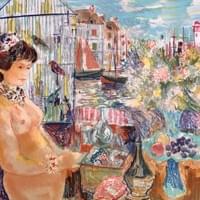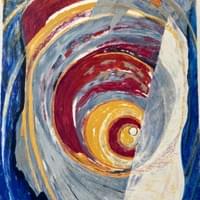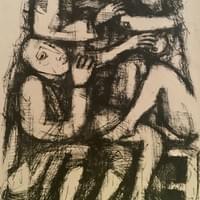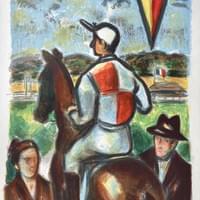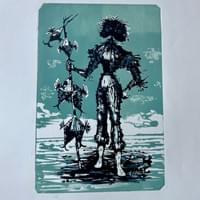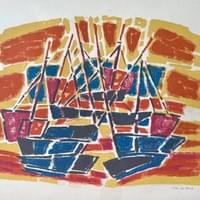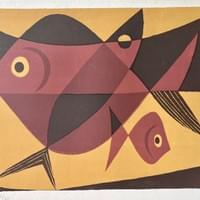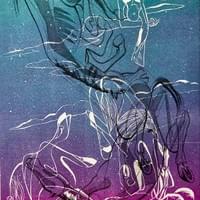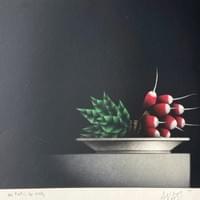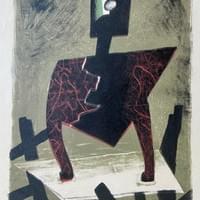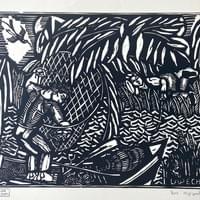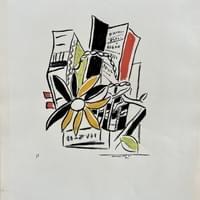

Castelli Carducci Gallery
https://www.artcollectorshop.com
Castelli Carducci Gallery at ArtCollectorShop.com
Is very proud to release for purchase fine original prints produced by
mid-20th century artists of the School of Paris.
Our private collection features lithographs and etchings each in small hand signed and numbered editions often in bold colors and employing the artistic innovations of the day such as Fauvism, Cubism, Abstraction, Surrealism, Modernism and Contemporary. Our wide ranging and comprehensive collection of the historic School of Paris era and artists, offers collectors and museums the rare opportunity to acquire exceptional works of art at
relatively modest price points.
Collection
Examples of works offered in this collection include an intensely chromatic abstraction of sailboats by French artist Jean Le Moal, other gems offered include a colorful biomorphic abstraction by the American artist Roderick Fletcher Mead. Also of note is a brightly surrealist color lithograph by influential French artist Jean Lurcat. Surrounding these School of Paris artists from around the world,were their high profiled contemporaries, revolutionary innovative artists such as Pablo Picasso, Marc Chagall, Henri Matisse and George Braque. We invite you to enjoy our online exhibition and the opportunity to acquire exceptional works of art.
Shop Now
View our lithographs and etchings


Artist Maurice Mourlot French 1906-1983
$250.00
Original color lithograph artist signed and numbered.
Limited edition 19/220.
Artist biography and information on website.
Size:12 " x 19.5" Very good conditionQuantityComing soon

Artist Gerard Cochet French 1888-1969
$300.00
Original color etching, signed and numbered by artist.
Polo scene
Limited edition 189/220
Artist biography and information on website.
Guilde de la Gravure
Size: 10.5" X 19.5"
Very good conditionQuantityComing soon

Artist: Eduoard Righetti French 1924-2001
$600.00
Original etching, artist signed and numbered.
Limited edition 76/120
Guild de la Gravure
Size: 7.75" H x 14.25" W
Very good conditionQuantityComing soon

Artist Unknown
$1,800.00
Black and white abstract etching.
Artist signed and numbered.
Limited edition 218/220
Guilde de la Gravure
Size: 5" H x 13" W
Very good conditionQuantityComing soon

Artist Philippe Henri Noyer French 1917-1985
$600.00
Original lithograph artist signed and numbered.
Limited edition: 73/175
Guild de la Gravure
Artist biography and information available on website.
Size: 19" H x 12" W
Very good conditionQuantityComing soon

Artist Jose Maria Pelayo Uruguay 1956
$400.00
Original color abstract lithograph, artist signed and numbered.
Limited edition: 107/220
Guilde de la Gravure
Artist biography and information on web site
Size: 16" H x 11" WQuantityComing soon

Artist Jose Maria Pelayo Uruguay 1956
$400.00
Original color lithograph, artist signed and numbered.
Limited edition: 62/175
Guilde de la Gravure
Artist biography and information on website
Size: 11"H x 17" WQuantityComing soon

Artist Emmanuel Auricoste French 1908-1995
$700.00
Original color lithograph, artist signed and numbered.
Artist biography on web site
Limited edition 125/200
Guilde de la Gravure
Size: 12.5" H x 19" WQuantityComing soon

Artist Jacques Truphemus French 1922-2017
$1,300.00
Sans Titre
Abstract lithograph in colors
Artist signed and numbered. Limited edition 5/40.
Size: 17" H x 13" WQuantityComing soon

Artist Dany Lartique 1921-2017 French
$650.00
Title: Bateaux
Original color Lithograph artist signed and numbered.
Edition: 75/220
Guilde de la Gravure
Size: 15" H x 18" WQuantityComing soon

Artist Paul Colin
$700.00
Artist history available on our web site- featured artists
Title: La Charite
Medium: Color lithograph
Date: 1970
Signature: artist pencil signed and also signed in the plate
Edition: 34/60 limited edition
Dimensions: 17"H X 10" W
Very good conditionQuantityAll options are out of stockComing soon

Artist Francois Desnoyer
$350.00
Artist history available on our website- featured artists.
Title: Portrait de Souza
Medium: Color lithograph
Date: Mid 20th Century
Signature: artist pencil signed, numbered.
Edition: 95/175
Dimension:13' H X 9 1/2" W
Very good conditionQuantityComing soon

Artist Yves Brayer
$1,900.00
Artist history available on our website- featured artists
Title: Les chevaux de cirque
Medium: Color gouache
Date: 1950
Signature: artist pencil signed ( Guilde De La Gravure)
Edition : 2/9 , limited
Dimension 11" H X 16" W
Very good conditionQuantityComing soon

Artist Suzanne Duchamp
$1,500.00
Artist history available on our website - featured artists.
Title: Anemones
Medium: Color Lithograph
Date: Early mid 20th century
Signature: artist signed on lithograph and also on plate
Edition: 153/220
Dimension: 13.5" H X 19" W
Very good conditionQuantityComing soon

Artist Roderick Fletcher Mead
$1,100.00
Title:Phaeton
Artist history is provided on our website - featured artists.
Medium: Color Lithograph
Date: Mid 20th Century
Signature: pencil signed by artist
Edition : original, limited edition 191/200 Guilde de la Gravure
Dimension: 15.5" H X 9.5" W
Good ConditionQuantityComing soon

Artist Francois Desnoyer
$950.00
Artist history is provided on our website - featured artists.
Titled: untitled Seaside abstract
Medium: Black and white original lithograph signed and numbered
Date: Mid 20th Century
Signature: original pencil signed ( Guilde De La Gravure)
Edition 37/200 limited edition
Dimension: 13" H X 15" W ( including signature)
Very good conditionQuantityComing soon

Artist Paul Charlot
$500.00
Artist history is provided on our website.
Whimsically rendered forest scene Original lithograph artist signed and numbered.
Abstract whimsical forest
Medium: Color Lithograph
Signature: artist pencil signed
Edition : 89/175 limited edition
Dimension: 17" H X 14" W
Good ConditionQuantityComing soon

Artist Georges Lambert
$400.00
La Bouquetiere Original lithograph signed and numbered. Limited edition.
Artist history is provided on our website.
Title: La Bouquetiere
Medium: Color Lithograph
Date: 1957
Signature: pencil signed by artist " GG stamped"
Edition: 151/220
Dimensions: 13 1/2" H X 21" W
Condition: Very GoodQuantityComing soon

Artist Jean Signovert
$800.00
Sans Titre 1957 Etching and aquatint. Original signed and numbered.Limited edition.
Artist history is provided on our website.QuantityComing soon

Artist Michel Rodde
$600.00
Abstract still life Original lithograph signed and numbered. Limited edition.
Artist history is provided on our website.QuantityComing soonLoad MoreMid 20th Century Artists
GALLERY
School of Paris Lithographs, Etchings and Engravings
available for purchase.

School of Paris Artists
Biographies and Information
Featured Artists
Original hand signed and numbered.
#1. Emilio Grau Sala (Spanish, 1911-1975) was born in Barcelona and studied at the School of Fine Arts in his native town, in 1929 he moved to France and became part of the Paris School of artists, where he developed his own style as a painter and printmaker. He became well known for his use of intense color in combination with lyrical interpretations of daily life in the city, the circus, figures, landscapes, themes of lively entertainment and casual leisure. In 1937 he was awarded the Carnegie Prize in Pittsburgh, resulting in growing popularity of his work in Europe and abroad. He would also become recognized as a book illustrator, creating images for editions by authors such as Baudelaire, Flaubert and Maupassant.
#2. Alice Halicka ( Polish/French, 1884- 1975) was an important painter and printmaker born in Krakow, Poland. Early in her career, she embraced Cubism, but would later focus more on collage and fabric design. She moved to Paris in 1912 where she received her art education at Academie Ranson under Paul Serusier and Maurice Denis. There she met and married the Cubist painter Louis Marcoussis ( 1878 - 1941) . The coupe often exhibited their work together at the Society of Independent Artists, where her work quickly gained recognition. Halicka would later exhibit more widely, both regionally and abroad, including the Leicester Galleries in London (1934), and the Marie Merriman Gallery and Julien Levy Gallery in New York(1936, 1937). She was also known for her set designs for ballets, including many performed at the Metropolitan Opera in New York, and Covent Garden in London. Halicka's works are held in public and private collections throughout the world, including the Barnes Foundation in Philadelphia Pennsylvania.
#3. Georges Rohner ( French, 1913-2000)was a Paris born painter and printmaker of international repute. Known stylistically as a realist, his creative endeavors often edged towrd surrealism. He studied at the Beaux-Arts in Paris, France under the French painter and teacher, Lucien Simon (1861-1945). Rohner also had an active teaching career, first as a lecturer at the Ecole de Beau Arts, and then by 1962, as a professor at Ecole Nationale Superieure des Arts Decoratifs, both in Paris. In 1963 he was awarded the Order of Arts and Letters. Later that decade, Rohner was elected to the Academie des Beaux Arts, Paris where he held the chair of Ingres. The Museum of Fine Arts in Quimper, France held a retrospective of Rohner's oeurve in 1987. Rohner's work has been exhibited regularly throughout Europe and the United States, including the Venice Biennale, nd Wildenstein & Co. in New York.
#4. Pierre Palue' (1920-2005) was a painter, watercolorist, and printmaker, born in Bordeaux, France. He depicted portraits, landscapers, harbor scenes, and the daily activity of city life, using richly colored simple forms in a style bordering close to realism, but with an underlying complexity. He attened L'Ecole d'art de Valence in 1941, later working with Andre'Lhote, Alexander Garbell, and Gustave Bolin. Palue exhibited his work throughout France, including an exhibit in Paris in 1945, and in 1947 at the Dromes, in Chavannes.
#5. Ivan Mosca ( Italian, 1915-2005) was a visual artist who experimented in a variety of media, including painting, pencil, watercolor, and printmaking. His style and approach to his subject matter was unique, often focusing on the immediate surroundings of plant life and insects and rendering them into abstract modernist compositions of ethereal quality. Born in Parma, he moved to Milan to study at the nearby L' Istituto Superiore per le Industri Artistiche, in Monza. He became interested in abstract art and the Gallery ll Milone, a contemporary art gallery founded in 1930 where artists such as Osvaldo Licini, Manlio Rho, Mario Radice, and Atanasio Soldati , often exhibited. He moved to Rome in 1936 to study at the Academy of Fine Arts. His work was exhibited and sold through the very influential gallery "L'Obelisco, founded by Irene Brin and Gaspero del Corso.
#6. Jean Couty ( French 1907-1991) was a French painter known for his depictions of landscapes, portraits, Romanesque churches, and still lifes, especially in and around the town of Lyon, France, his childhood home. He also designed ceramics and was an accomplished printmaker. He initially studied architecture at the School of Fine Arts architecture program in Lyon, and then the architecture graduate program at the Paris School of Fine Arts. After a brief period apprenticing under the noted French city planner and architect Tony Garnier, Couty turned his attention to painting full time. He developed a style that defies distinct categorization, combing elements from various movements of the day, including post impressionism, fauvism, and abstraction. He was represented by the Granoff Gallery in Paris for more than 40 years and obtained numerous prizes and awards throughout his storied career. The Jean Couty Museum in Lyon, opened in 2017 to the public, houses and exhibits more than 200of the artist's works.#7. Pawel August Konty ( Polish/American 1923-2002) was a Polish born artist who lived and traveled extensively in Germany and throughout Europe, but who eventually settled in the United States to become a well known painter of the Southwest. In 1945, in Italy, he was captured by allied forces and became a prisoner of war. After the war, Konty trained as an architect at the Union of Nuremburg Architects and would assist with the design and rebuild of battle-torn Europe. As an artist, his work in architecture would forever color his style and choice of subject matter. This was realized in his unique mixture of realism and abstraction, especially evident in his later depictions of adobe structures in Taos, and Santa Fe , New Mexico. Konty built an extensive career resume, exhibiting tirelessly in Europe in the late 1940's and 1950's, with solos shows at Bibliotheque Francaise, Nuremberg, Germany (1950); Galerie Schroder, Munich, Germany(1954); Galerie Prestel, Frankfurt (1952-1954); Galerie Stenzel, Munich Germany ( 1954); Hamburger Kunstlerclub "Die Insel", Hamburg, Germany (1956). This continued in the United States after his initial travels there and after he became a permanent resident, with solo exhibitions at TheLittle Studio, New York (1957); Marshall Fields, Chicago (1957); Pogzeba Art Gallery, Denver (1958); Saks Galleries, Denver , Colorado (1962, 1967, 1968, 1972, 1974, 1984, 1995, 2014); 5201 Galleries, Oklahoma City ( 1962); Maxwell Gallery, San Francisco ( 1963, 1972); New Mexico Museum of Art, Santa Fe (1963); and numerous other locations including the Fukjin Gallery, Tokyo, Japan (1992).
#8. Jean Lurcat ( French, 1892-1966) was a French artist best known for his singular role in the revival of tapestry as a respected contemporary art form. In addition to this, he gained renown in a variety of other media, including ceramics, tile, painting, print making and poster design. He work often portrays semi- abstract figural forms inspired by nature, animals and the cosmos, at times rendered in an art nouveau style. Born in north eastern France in the town of Bruyeres, Lurcat moved to Paris in 1912 and studied at the Academie Colarossi, then at the workshop of the artist and engraver Bernard Naudin. While there he met painters such as Matisse, Cezanne, Renoir, and befriended Antoine Bourdelle and the Austrian poet and writer Rainer Maria Rilke. He traveled and worked extensively in the United States and Russia, often creating backdrops for various theater and opera companies. Solo exhibitions of Lurcat's work include the Bignou Gallery, New York, and the Anglo-French Centre, London (1946); Musee National d' Art Moderne, Paris (1958); and the Stiebel Gallery, Paris(1961/62). His work can be found in the permanent collections of Musee Nationale d' Art Moderne, Paris; the National Gallery, Washington D.C.; and the Detroit Institute of Fine Arts, Michigan, among others.
#9. Alexandre Sascha Garbell ( Latvian, 1903-1970) was a painter and printmaker affiliated with the Paris School of Artists, who incorporated a unique combination of Cubist and representational elements into his renderings of colorful harbor scenes , townscapes, and beach scenes. Born in the town of Riga, Latvia, he first studied art in Moscow, and then moved to Paris in 1923 where he attended the Academie Ranson with the stained-glass artist Roger Bissiere. Garbell eventually exhibited in some of the most prestigious venues in his day, including the Salon des Superindependants, the Salon des Tuilieries, the Salon Automne and the Salon de Mai. After WWII, he showed extensively in Europe, London, and the United States.
#10. Marcel Mouly (French, 1918-2008) was an important French modernist painter and printmaker who focused on semi-abstract depictions of harbor scenes, still lifes, figural studies and landscapes, with an overarching emphasis on color and the Fauvist impulse. Born in Paris, Mouly was one of the last surviving students of Picasso, and an apprentice under the French Cubist painter Fernand Leger. His work has been exhibited throughout Europe and the United States in institutions such as the Musee Nationale d' Art Moderne and Bibliotheque Nationale in Paris, Musee de Geneve in Switzerland, and the San Francisco Museum of Modern Art. He is the recipient of two of France's most distinguished honorary awards in the arts; He received two of France's highest art awards: the Chevalier de L'Ordre des Arts et Lettres in 1957 and the Premier Prix de Lithographie in 1973.
#11. & #55. Andre Hambourg ( French, 1909-1999) is best known for his post-impressionist paintings depicting beach scenes with numerous figures under expansive brightly lit cloudscapes. In his distinctive luminous style, he also painted Paris and its environs, harbor scenes, and landscapes. Hambourg studied first at the Ecole des Arts Decoratifs, in Paris, from 1926 to 1930, with the important sculptor Paul Francois Niclausse. He then apprenticed under the painter and teacher Lucien Simon at the Ecole des Beaux-Arts, before leaving to work in various studios in Montparnasse, just south of Paris. He would spend 10 years living ion Morocco and Algeria, before the interruption of WWII, where he became a reporter and draughtsman for the newspaper of the French army, working under the pseudonym of Andre' Hache. After the war, he took up painting full time, living and working mostly in Normandy, where he opened a studio. In the early 1950's, he returned to the armed services as an official artist of the French navy. Sketches and preparatory drawings of his many voyages would soon become the subject matter and basis for much of his art, and for use as illustrations in collector's editions in books , such as the Return of Imray by Rudyard kipling (1956), and the Posthumous works by Albert Camus (1979). Two important galleries represented Hambourg from the 1960's onward : Galerie Paul Petrides in France, and Wally Findlay Galleries in the United States. This commercial success allowed Hambourg the flexibility to pursue other artistic diciplines including lithography, tile, mosaics, and large public commissions , including a 195 ft square mural for the European Court of Justice in Luxembourg, completed in 1972. Hambourg's works can be found in the permanent collections of the Musee National d' Art Moderne and the Musee d' Art Moderne de la Ville, in Paris, and in the Eugene Boudin Museum in Honfluer, among numerous others.
#12. & # 67. Maurice Louis Savin ( French 1894-1973) was a French painter known for his depictions of peasants, farmers harvesting, figures in gardens, interior scenes and nudes, often using simple but subtly complex forms in "soothing" golden colors. A graduate of the School of Decorative Arts in Paris, Savin was also a noted printmaker, illustrator, tapestry maker, ceramist, sculptor and worked with stained glass. Conscripted into the French military and wounded in WWI, he was awarded the Croix de Guerre. He worked as an illustrator for numerous magazines of his day while also participating in major exhibitions in Paris, including the Salon d' Automne, in 1933. He is known for his 1935 mural for the grand staircase of City Hall in the town of Montelimar, in southeastern , France.
#13. Maria Morgan Snell ( Brazilian, 1920-2007) was a self taught artist born in Sao Paulo, Brazil. She moved to France in 1948, quickly immersing herself into the Paris School of artists where she received numerous commissions for murals and churches. The subject matter and style of her work is unique, often portraying the human body in heroic forms and drawing inspiration from Homeric, Biblical or mythological stories.
#14. Jean Crotti ( Swiss / French, 1878-1958) was an important early modernist painter born in Bulle, Switzerland. He studied first in Munich, Germany at the School of Decorative Arts, then at age 23 moved to Paris to study at the Academie Julian. Early in his career, a confluence if styles influenced his work, including Impressionism, Fauvism, and Art Nouveau. By 1910 he began to experiment with Orphism, and extension of Cubism, that he further developed through his association with Marcel Duchamp and Francis Picabia, during his brief stay in New York after WWI. In 1916, he returned to Paris. His reputation grew, and in 1925 he took part in the Exposition International in Paris. In 1926-1927, he exhibited at the International Exhibition of Modern Art, at the Brooklyn Museum. In the following years, many solo shows of his work took place throughout Europe, England, and the United Sates.
#15. Jean Schuler (German/French, 1914-1984) was a multi-faceted painter born in St. Ingbert, Germany. His work is characterized by intensely colored figurative abstractions, often employing simple forms, yet defying easy explanation. He is known to have studied in Munich at the Academy of Fine Arts under the German artist Karl Caspar (1879-1956), followed by a stay in Berlin where he developed and association with the important expressionist painter, Emil Nolde. He moved to France in 1949 and became part of the Paris School of Artists, exhibiting in numerous exhibitions in the surrounding region and Germany.
#16. Suzanne Tourte (French, 1904-1979) was a stylistically diverse artist known for her colorful depictions of landscapes, figures, still lifes and village scenes. Born in the town of Cormontreuil in north eastern France, she was known to have been a refugee in Paris from 1917-1919, as a result of WWI. Tourte overcame this obstacle, and from 1920-1930, studied at Ecole de Beaux Arts in Reims and in Paris. Notably, she was awarded the Blumenthal prize in 1932 for engraving, and as a result, began exhibiting throughout France and Europe. In 1946, she created a series of frescos in the chapel of Langogne, France. Her final solo exhibition was at the Nouvel Essor Gallery in Paris, in 1979.
#17. Maurice Verdier ( French, 1919-2003) was an accomplished 20th century French painter and printmaker known for his colorful and impressionistic depictions of still lifes, landscapes and Paris street scenes, and villages, often in a style reminiscent of Bernard Buffet. Verdier apprenticed at the Ecole des Beaux-Arts in Paris along with fellow students Gaetan de Rosnay, Paul Augustin Aizpiri, and Roger Montane. Early in Verdier's career, he was awarded the prestigious traveling scholarship, the Feneon Prize. He exhibited at the numerous salons of the day, and had so many solo gallery exhibitions throughout Paris, including the Galerie Roux-Hentschel in 1947, regularly at Galerie Francis Bartlier until 1997, and a retrospective held at Galerie Deprez-Bellorget in 1997.
#18. Jacques Truphemus ( French 1922-2017) was a French painter known for his unique interpretation of 19th Century impressionism and the works of Claude Monet. Born in Grenoble , where he lived and worked in his career, he eventually settled in the town of Lyon, France, and the Cevennes region, incorporating its landscape, people, misty harbor and distinctive light, into his oeuvre. He studied under Rene' Chancrin, Jacques Laplace, Antoine Chartres and Henry Vieilly, at the School of Fine Arts in Lyon, from 1942 to 1945. The work of Truphemus has been exhibited in numerous group shows throughout France, particularly those featuring Lyonnais painting. He had solo exhibits of his work in Paris at the Galerie Claude Bernard and in Annecy, Grenoble, Nice, Basel, Lausanne, and Nantes.
#19. Louis Berthomme' Saint-Andre' (French 1905-1977) was a painter, lithographer, and watercolorist, who became well known for his boudoir portraits rendered in a style reminiscent of Paul Cezanne and French post-impressionism. Born in northern France in the town of Barbery, Berthomme' Saint Andre' initially studied architecture but soon shifted to painting in 1921 upon entering the Ecole des Beaux-Arts in Paris, where he studied
under Fernand Cormon and Jean Paul Laurens. He exhibited in many of the major salons in Paris throughout the 1920's and 1930's, winning numerous medals and competitions, including the Abd-el-Tif Prize in 1925, a scholarship allowing a years free study and work in Algeria. As a result of this experience, Berthomme' Saint-Andre' returned to Africa on numerous occasions, greatly influencing the artist's style and choice subject matter. Later in his career, he created illustrations for literary works by Apollinaire, Baudelaire, Doderot, and Voltaire. His works are held in museums and institutions in Europe, Africa, and the United States, including the National Museum of Fine Arts in Algiers, the Museum of Art and History in Narbonne, the Angouleme Museum in France, and the National Gallery of Art in Washington, D.C..
#20. Richard Bellias (1921-1974) was a French painter known for his landscapes, beach scenes, and still lifes. He painted in post-impressionistic style that edged toward expressionism, due in large part to the influence of his most important mentor and teacher, the Australian born artist Edouard Joseph Goerg. He studied at the Academies libres in Paris. He then apprenticed under Othon Friesz at the Academie de la Grande Chaumiere, and later under the sculptor Robert Wlerick at the School of Art Appliques. Then in 1946 he meet Goerg, which greatly influenced his use of color, style, and technique. This led to numerous accolades, including first prize in 1957 and 1959 at the Salon for young painters. Bellias exhibited at various galleries throughout Paris including the Monique de Groote Gallery, and the Jean-Calude Bellier Gallery.
#21. & # 22 Jean Dries, pseudonym for Jean Driesbach ( French, 1905-1973), was an important French painter, watercolorist, and printmaker, known for his landscapes of Normandy and Provence, still lifes, nudes, harbor scenes, and equestrian subject matter. Though he considered himself independant of any art movement, his style and use of color is reminiscent of Fauvism and French post-impressionism. Born in Bar-le-Duc in Meuse, in northeast France, he moved to Paris and studied under Lucien Simon at the Ecole des Beaux-Arts. After a number of years of exhibiting at the various Paris salons, including the Societe' des Artistes Independents and Salon Tuileries, Dries moved to Provence in 1930, setting up his last studio in Aurel, Vancluse. He traveled extensively, teaching at the French colonial school in Setif, Algeria and in 1940 on assignment by the French government, he was sent to Mendoza, Argentina to teach at the University of Coyo to promote French culture. Later he would become involved in the arts administration in the region of Normandy: he co-founded the Societe' des Artistes Honfleurais, which for fifty years organized an annual show, and in 1950 he was the assistant curator of the municipal Honfleur Museum, becoming chief curator in 1953. During his lifetime, Dries exhibited regularly at galleries in Paris, and abroad in Argentina, and the United States. Upon his death in Paris in 1973, major retrospectives of his work have been held at Gallery Braquehaye in Honfleur ( 1977), Gallery Boisseree am Museum in Cologne, Germany (1979), and Musee Eugene Boudin, Honfleur (2005).
#23. Edouard Righetti ( 1924-2001) was a French post-impressionist painter and printmaker known for his landscapes, figures, scenes of nature, and animals, often with vivid coloration, but contrasted against thematic suggestions of melancholia. Born in Switzerland in Menton, Righetti moved to France to study at the Ecole des Beaux-Arts in Montpellier. He then continued his training at the School of Decorative Arts in Nice. In 1949, he met artist and teacher Eduoard George and was admitted to the Ecole des Beaux-Arts in Paris, where he apprenticed in his studio until 1954. In 1956 he obtained the prestigious Casa Velasquez scholarship, a two year grant to study in Madrid. Righetti's work has been exhibited in group shows and also solo exhibitions throughout France, including Galerie Greuze, Paris (1959), Musee des Beaux-Arts, Tours (1964), Galerie Bernier, Paris (1965), and Berheim-Guiot Gallery, Paris (1985). The National Library of France houses more than 200 of his works in their Department of Prints and Photography.
#24. Jean Marzelle (French,1916-2005) was a School of Paris painter and printmaker known for his colorful, semi-abstract still lifes, quiet harbor scenes, portraits, and landscapes, in a style that combined elements of Fauvism and Cubism. He first studied at the Ecole des Beaux-Arts in Montpellier, and then enrolled in the Ecole des Beaux-Arts in Paris, in 1935. In the 1040's he befriended the artist Francois Desnoyer, who encouraged his development, and hired him as an assistant for a major mural in the town hall of Cachan, south of Paris. Soon after, he began exhibiting in the various Paris salons and galleries of the day, including Salon d'Automne, and the Salon de Mai, showing regularly at the latter until 1978. In early 1950's he traveled extensively through Spain, returning to France and exhibiting works with a fresh look, winning numerous prizes, including the 1957 Prix de la Critique, awarded by Galerie Saint-Placide of Paris. In addition to painting and printmaking, Marzelle worked in a variety of media throughout his career, including the book arts, illustrating several collector's editions, including 1964 publication of Paul Verlaine's "Fifteen Days in Holland: Letters to a Friend". He received commissions for large public mosaic projects, and worked in stained glass, designing a series of windows for chapel of Moulin De Vauboyen in Essonne, France. Marzelle's work can be found in major private and public collections throughout Europe and the United States. His estate is currently represented by Galerie Jean-Pierre Joubert, in Paris.
#25. Balthus, pseudonym of Balthaser Klossowsky( French, 1908-2001)was a Paris born painter best known for his austere landscapes, surrealist portraits, and controversial depictions of adolescent girls. Living in the midst of European modernism, Balthus chose to explore traditional categories of European painting in new and subtly subversive ways. His parents were active in the intellectual and artistic milieu of Paris, through which Balthuus met the poet Rainer Maria Rilke, who encouraged his artistic talents at an early age, and who together, would publish a book of sketches accompanied with Rilke's poetry. Balthus would receive his first one man show in Paris in 1934, after which, he turned his time and attention to large-scale interiors and landscapes, displaying ordinary life on a grand scale, often with thematically dark, suggestive undertones. He would eventually receive major retrospectives
of his work at the Museum of Modern Art in New York City in 1956, the Georges Pompidou Centre in Paris in 1983, and the Metropolitan Museum of Art in New York City in 1984. He served as the director of the French Academy in Rome from 1961 to 1977, and at age 83, was awarded the Japan Art Associations Premium Imperiale prize in 1991 for his painting.
#26. Louis Favre ( French, 1892-1956) was a self taught artist, writer, and inventor, who spent most of his life in France and the Netherlands. He worked in a variety of media, eventually settling upon lithography as his primary form of artistic expression. He befriended writer and feminist Gertrude Stein while in Paris early in his career, a connection that helped to propel Favre's popularity in the United States. He would later develop a friendship with the cubist sculptor Jacques Lipchitz, a relationship that profoundly impacted Favre's style and technique, most visible in his stylized, elongated depictions of human form. Favre became well known in the Netherlands as an illustrator of fine book editions for the renown Stols, and Mouton et Co., long established publishers in the Hague, producing sketches for works by Edgar Allen Poe, Arthur Rimbaud, and numerous other celebrated writers and poets. Favre's exhibition history is extensive, including the Victoria and Albert Museum, London (1948), The Redfern Gallery, New York ( 1951), Exposition Milan (1954), and the Groninger Museum, in Groningen , the Netherlands (2005).
#27. Hans Stocker ( Swiss 1896-1983) was a pioneering Swiss born modernist painter known for his colorful landscapes, still-lifes, fugural works and seascapes. He worked in a variety of media including oil, watercolor, charcoal, lithography and woodcut. He became especially well regarded for his work in stained glass for churches and public buildings throughout Switzerland, Europe and even Japan, where he designed a series of panels for the Kawaramachi Cathedral for the Catholic Diocese of Kyoto. Stocker incorporated into his work many of the avant gsrde trends of his day, including Fauvism and Expressionism. Themes of family, mother and child and community dominated his work. Stocker began his studies under the artist Albrecht Mayer at the general trade school in Basel, his native town. He later moved to Geneva befriending painters Alexandre Blanchet and Hans Berger. He would eventually move to France, working in Paris from 1925 until the outbreak of WWII, whereupon he returned to Switzerland. Stockker was a founding member of several important art associations and salons, including the Paris based Salon des surindependants, and the Swiss Gruppe Rot-Blau. The latter helping to establish the movement of Expressionism within Switzerland. Retrospectives of Hans Stockers work have been held at Kunsthalle Basel, one of the oldest museums in Switzerland, in 1948, 1961, and 1976. Stocker's work can be found in public buildings and churches throughout Switzerland, including his 1932-1933 mural Bathing Children in the stairwell of the Kirschgarten high school and his 1966-1967 stained glass windows in the chapel of the Felix Platter Hospital, both in Basel.
#28. Madeline Luka ( French, 1894-1989) was self-taught naive painter known for her landscapes, portraits, nudes, and still-lifes. She typically portrayed her family and close circle of friends set within gardens in a folk-art style that evoked themes of innocence, grace, and solitude but edged toward surrealism. She was also an accomplished print maker, tapestry artist, and authored and illustrated numerous books, including A ma Lucarne, published in 1959; her autobiography Voltiges published in 1970; and the Poems of Madeline Luka, published in 1940. Her work is held in the Musee du quai Branly-Jacques Chirac, in Paris, and also at Galerie de Sevres, also in Paris. She exhibited regularly alongside the important avant-garde artists of her day, including Salvador Dali, Marie Laurencin, and Tsuguharu Foujita.
#29. Lucien Coutaud (French, 1904-1977) was an important French surrealist painter, printmaker, and tapestry artist, known for his still-lifes and isolated figures set in landscapes and interiors reminiscent of Salvador Dali, often with erotic undertones. He was also recognized internationally as a decorator and set designer for countless theatre, dance and opera productions in France, Italy and Japan, including decor for the Shakespeare play As you Like It, in a 1938 production in Florence and set design for a 1945 production of the ballet Le Poete, staged at the Sarah Bernhardt theatre in Paris. Coutaud exhibited his work tirelessly throughout his career, including a 1946 show at Galerie Maeght in Paris; a 1965 survey at the Chateau-Museum of Cagnes-sur-Mer in the French Alps; and a 1953 retrospective at the Kamakura Museum of Modern Art in Japan. Coutaud also worked extensively in the medium of gouache, often depicting esoteric dreamlike abstractions of bull fighting and the dramaturgy of death.
#30. Jean Remlinger (French, born in 1935), is an important French post-war contemporary painter and graphic artist known for his stark, semi abstract figural compositions, landscapes, and harbor scenes, suggestive of the work of Francis Bacon. His most recent work features ghost-like portraits with blank, erased faces, absent of any emotion, and devoid of any subject meaning. Remlinger has exhibited extensively in group and solo shows throughout France, Germany, and Switzerland, including the Museum of Modern Art in Strasbourg, France; The Panacee Contemporary Culture Center in Montpellier, France; and Gallery Court Saint Pierre in Geneva, Switzerland.
#31. Nicolas Carrega (French, 1914-1992) was a French painter, printmaker and sculptor who produced portraits and figural works using simple forms in a limited array of soft-toned colors. Carrega would later turn towards geometric abstraction, using bold blocks of color in his paintings and prints reminiscent of Pierre Soulages, and sharp-edged cubistic formulations in his sculpture, at times suggestive of the work of Jacques Lipchitz. He studied in the free workshops of Montparness and exhibited in the numerous salons of Paris, including the Salons des Independants, the Salon d' Automne, and the Salon des Realites Nouvelles. He also produced many decorative compositions for public buildings and became known for his copper relief commemorative medallions produced at the French mint, depicting various well known politicians, artists and writers, including Charles de Gaulle, Alexander Caulder, and Leo Tolstoy.
#32. Jean Le Moal ( French, 1909-2007) was a French painter, watercolorist, and printmaker known for his colorful abstract compositions, often suggesstive of geometric shapes and forms found in nature, such as tree patterns, cloud-like shapes, water and grasses. A School of Paris artist LeMoal also worked as a designer of stained glass windows and was a founding member of the Salon de Mai, a group of French artists which formed in a cafe on the Rue Dauphine in Paris in 1943, in opposition to the Nazi occupation and their indictment against the works of art deemed "degenerate". Le Moal enrolled at the "Ecole des Beaux-Arts de Lyon" in 1926, and the Ecole nationale superieure des arts decoratifs in Paris in 1929. He also attended the "Academie Ranson" from 1935-1936. In the post-war years LeMoal exhibited extensively throughout Europe and internationally, including La Juene Peinture Francais, Palais des Beaux Arts, Brussels 1945; Exposition d' Art Contemporain, Berne, 1946; L'Ecole de Paris, 1900-1950, London, 1951; Tokyo 1960; and Munich 1963. His work is held in major museums worldwide, notably the Tate, London; City of Paris Museum of Modern Art, Paris; and the Henie Onstad Art Center, Norway.
#33. Leon Gischia (French, 1903-1991) was a School of Paris artist known for his bright palette and experimentation with the juxtapositon of fragmented natural forms and shapes, suggestive of Matisse and Picasso. Primarily an abstract arist, Gischia also produced figural compositions, portraits and still lifes. He worked in a variety of media including oil, watercolor, gouache, and the graphic arts. He also designed costumes and sets for the Theatre National Populaire in Paris and wrote several important books on sculpture and the movement of Primitivism. Born in southwestern France in the town of Dax, Gischia moved to Paris in the 1920s where he studied under Fernand Leger in his Montparness studio. Gischia's first major project was his collaboration with Leger on Le Corbusier's radical designs for the Pavillon desTemps Nouveaux, part of the 1937 International Exhibition in Paris. Therafter, his reputation and critical acclaim accelerated, leading to a long term gallery representation with the influential Parisian art dealer and publisher Jeanne Bucher, and later with Galerie Billiet-Caputo. The latter relationship would help establish Gischia internationally, culminating in his reprensenting France at the 1948 Venice Biennale. This cemented Gischia's reputation, leading to long-term representation at private galleries thoughout the world. His work is held in numerous museums, notably Musee National d'Art Moderne, Centre Georges Pompidou, Paris; LeHavre; Marseille; Amsterdam; Liege; Brussels; Turin; and the Victoria and Albert Museum, London. He has been given retrospectives at the Paris Art Centre, 1985; Galeire d'Art International Paris, 1988; Musee de Zagrebe, 1988; Musee de Borda, 1988; and the Paris Art Centre, 1990.
#34. Andre Marchand ( French, 1907-1997) was a painter and graphis artist known for his semi-abstract still lifes, figural studies, and landscape compositions, often depicting the region around Aix-en Provence in southern France, where he was born, and where he spent much of his life working as an artist. His style is often compared to that of Raoul Dufy and Henri Matisse, both of whom he greatly admired. A School of Paris artist, Marchand was a founding member of the Salon de Mai, a group of French artists who were opposed to the Nazi condemnation of the so called " degenerate art". Marchand received most of his early training at the free academies in Montparness. He gained recognition by exhibiting his work at the important Paris salons of the day, including Salon d'Automne and the Salon des Independants. By the 1940's he reached international success , helped along by the support and encouragement of the collector and gallery owner Aime Maeght, who held a critically acclaimed solo exhibition of the artist's work in 1946. He would later be invited to show his work at the art biennale of Sao Paulo in 1951 and Venice 1954. A thirty year retrospective of his paintings was held at the Reattu Museum in Arles, France, in 1963. His work is held in imporant private collctions and public museums around the world, such as the Museum of Modern Art in New York, the National Gallery of Art in Washington, D.C., and the Museum of Modern and Contemporary Art in Liege, Belgium.
#35. Shungo Sekiguchi ( Japanese/French, 1911-2002) was a Japanese born watercolorist and printmaker who beacame part of the new Paris School of artists. His depictions of Paris and its surrounding neighborhoods often show barren streets with one or two figures, combined with the use of rich coloration, reminiscent of Fauvism. Awarded a scholarship from the French government, Sekiguchi moved to France in 1935 to study at the Ecole des Beaux-Arts, in Paris. While there, he worked alongside other important Japanese artists of his day, including Takanori Ogisu and Tsuguji Foujita. WWII and the Nazi occupation of France forced Sekiguchi to return to his birthplace, but he never entirely abandoned ties with his "second home". He had gained a level of recognition in Paris, exhibiting in 1952 at the prestigious Salon d'Automne, and winning prizes and awards in France throughout the 1950's and 1960's. He also worked as a book illustrator for the French edition of Le demon dore by Ozaki Kohyo. In Japan he gecame well known as a wood block artist, and was a member of the Shin Haga movement, a group that produced color woodcuts in a more traditional manner and style, intentionally catering their sales to the European and American markets. Sekiguchi's work is held in the permanent collection of the Tokyo National Museum of Modern Art, in Tokyo, Japan. He is included in the Helen Merritt and Nanako Yamada's prestigious survey of the 20th Century Japanese printmaking, " Guide to Modern Japanese WoodblockingPrints: 1900-1975".
#36. Roderick Fletcher Mead (American, 1900-1972) was an important painter and printmaker, best known for his surrealist landscapes and figural compositions reminiscent of Pablo Picasso and artists of his circle. Born in South Orange, New Jersey, Mead received his formal training at Yale University where he earned his degree in fine arts, in 1925. Soon after he moved to New York City where he studied at the Art Students League under the renown Ashcan painter George Luks. From 1927-1929, he was enrolled at the Grand Central School of Art, where he studied watercolor under George Pearse Ennis, then considered the foremost watercolor teacher in New York. Atracted to the avant-garde movements occurring in Europe between the wars, Mead moved his studio to Paris in 1934, soon studying at the workshop of Atelier 17 under its founder, the influential Stanley Willian Hayter. There he built relationships with the many leading artists of Paris during that time, who were also working and studying under Hayter, including Picasso, Alberto Giacometti, Max Ernst, and Wassily Kadinsky. Much of Mead's colorful, biomorphic imagery produced with technically advanced techniques learned under Hayter, comes out of his understudy experience. With the looming onset of war, Mead returned to the United States, eventually settling in Carlsbad, New Mexico, where he taught classes and worked for the Potash Company of America, creating their company emblem, and designing their ore refining machines. The late 1950's and 1960's was a period of great output for the artist, where he produced large scale canvases and a variety of prints employing a mixture of techniques, including soft-ground, aquatint, engraving, and lithogrpahy, often depiciting geometric, surrealist forms. Mead's work is held in numerous private and public collections, including the Smithsonian American Art Museum in Washington, D.C., the Brooklyn Museum in Brooklyn, New York, and the Roswell Museum and Art Center in Roswell, New Mexico.
#37. Louis Touchagues (French, 1893-1974) was an important French artists who through his paintings, magazine and book illustrations, drawings, fashion design, porcelain, and murals, depicted much of Parisian life for over a half century. He often exhibited alongside other well known French artists such as Marc Chagall, Raoul Dufy and Marie Laurencin. Born in Lyon in Eastern France, Toughagues moved to Paris in 1923, where he began working as a commercial artist for various journals and publications, including L'Art Vivant, Paris-Journal, The Literary News, the satirical Le Crapouillot, and Le Charivari. Well recognized for his work as a sketch artist for the French parliament, he was awarded a commission by the Beaux-Arts de Paris to illustrate and document the first Paris Peace Conference following WWII. He also illustrated numerous books by popular and well regarded authors and playwrights of his era, including Colette, Sacha Guitry, and Marcel Ayme'. Additionally, he created and designed theatrical sets and costumes for various Paris theatre, opera and stage companies, including Theatre de la Michodiere, Opera Comique, and for Louis Jouvet at the Comedie Francaise. Major public and private works include frescoes and murals for the Franklin D. Roosevelt Paris metro station, painted glass windows at the Museum of Moderne Art in Paris, and a mobile ceiling at the famous gourmet restaurant Lasserre, in Paris.
#38. Abram (Abraham) Krol (Polish, 1919-2001) was a School of Paris artist known for his painting and fine prints depicting still lifes, landscapes, portraits, and city scenes, in a style that balanced juxtaposition of forms and objects found in everyday life, reminiscent of Cubism. Originally from Poland, Kroll moved to France in 1938 to study civil engineering at the University of Caen. At the outbreak of WWII, he joined the Foreign Legion. Upon demobilization, he worked in Avignon as a mechanic in a garage also while taking courses in sculpture at the city's School of Fine Arts. Although Jewish, he was able to survive the war by using false identities. In 1944, he settled in Paris and took up the study of engraving under fellow ex-patriot and master print maker Joseph Hecht. Hecht at that time was recognized internationally for his groundbreaking techniques in intaglio. He would go on to teach and pass on these innovations to many important artists of the day, including British Surrelist painter and printmaker, Stanley William Hayter. In 1946, Krol held his first major exhibition at the renown Katia Granoff Gallery, in Paris. Krol also designed and engraved medals for the Paris mint, painted murals for various schools throughout France, created tapestries, and produced over 200 works in enamel. His work is held in major private and public collections throughout the world, including Bibliotheque Nationale in Paris; the Victoria and Albert Museum in London; the British Museum; Houghton Library, Harvard; Bodleian Library, Oxford, and the Palace of the legion of Honor in San Francisco, California.
#39. Mario Avati (French, 1921-2009) was a French artist and printmaker known primarily for his ethereal and meticulous mezzotints. He depicted everyday objects in still life, either in black and white, or using subtle coloration, often against lush, black backgrounds, at times bordering on surrealism. His work is often compared to the great Japanese master mezzotint artist , Yozo Hamaguchi. Considered the most demanding of all print making techniques, mezzotints are created using copper plate that is hand "rocked" using a curved, notched blade until the surface is entirely pitted. At this stage, an inked plate would produce a rich, uniform black. From this point, the artist employs a scrapper or burnisher to flattened the raised portions. The extent to which an area is flattened, determines how much lightness the area has after inking and printing - areas burnished until the surface is completely smooth hold no ink, and thus print as white; areas left untouched print as completely black. Rocognized internationally, Avati's work is held in public and private institutons worldwide, including the Victoria et Albert Museum in London, the Kunstmuseum in the Hague, theUffizi in Florence, the Art Institute of Chicage, the Library of Congress and the National Gallery of Art in Washington, D.C., and the Museum of Modern Art in New York.
#40. Gaetan de Rosnay (French, 1912-1992) was a French artist born on the island of Mauritius. He worked primarily in oil, pastel, watercolor, and lithography, depicting still-lifes and figural works. In the post war years his style and subject matter changed to mostly ethereal and semi- abstract landscapes and color formations. He was a member of the important art movement known as the "La Jeune Peinture" along with other School of Paris artists Bernard Buffet, Yves Brayer, Paul Collomb and Gaston Sebire. His works are housed in major public and private collections throughout Europe and the United States.
#41, #76 - 81. Joseph Fernand Henri Leger ( French, 1881-1955) is largely considered one of the most important early 20th century Cubist painters, along with Picasso and George Braque. He was born in Normandy, and initially studied and apprenticed as a re-toucher of photographs and draughtsman in architecture. He abandoned his career path and in 1903 enrolled in the Academie Julian and the Ecole des Arts Decoratifs, in Paris. He first gained international recognition with his painting "Nudes in the Forest", exhibited in 1911 in the Salon des Independants, which showcased his break from Impressionism, and his own unique shift to Cubism, with its emphasis on cylindrical forms and the fracturing of objects into geometric configurations. Thematically, he is often compared to Italian Futurists, with their generally optimistic viewpoint toward pre-WWI industrialization, speed and new technologies. Often overlooked in the Leger's oeuvre is his work in a wide range of other media, including ceramics, film, theatre, dance sets, glass, printmaking, and the book arts. Though his renown was built as a Cubist painter, his style often fluctuated decade to decade between representation and abstraction, pulled from a variety of traditions. Leger's work is held in major public and private collections throughout the world, and has been the subject of important retrospectives, including the Museum of Modern Art in New York (1998), and the Museum Ludwig in Germany (2016).
#42. Cuno Amiet (Swiss, 1868-1961) was a Swiss born painter and a pioneer of modern art in Switzerland. He attended the Munich Academy of Fine Arts. Ameit collaborated with Giovanni Giocometti. He was commissioned by Hodler who had an impact on his success. He is an expressionist that worked with a sense of harmony of color in the French tradition. He was known for his vibrant portraits, landscapes, nudes, and still lifes. He also worked as a graphic artist, sculptor and illustrator. His style focused primarily of color and combined elements of French Fauvism and European expressionism.
#43. Ralston Crawford ( Canadian/American, 1906-1978) was a Canadian born American painter and printmaker recognized internationally for his pioneering work in the movement of Precisionism, a style that stressed flat colors, sharp edges with little texture, and embraced industrial images, such as grain elevators, bridges, railroads, and factory scenes, often reducing theses subjects to their essential geometric forms. Crawford also worked in the medium of photography, both as a tool for the painter and as an abstract medium itself. He studied in Los Angeles, Columbia University and Paris. He worked at U.S galleries such as Albright Knox art gallery. He grew up in Buffalo, N.Y. . His history is extensive and is known for his profession as painter, lithographer, illustrater, photographer, lecturer and teacher.
#44. & #69. Paul Colin (French, 1892-1985) was a French artist widely recognized for his imaginatively configured art deco posters depicting many well known theatre performers in Paris in the 1920's and 1930's, such as Josephine Baker and modernist figures and nudes. He also specialized in theatre sets, book design, and costume design. Influenced by Cubism and jazz, he often employed a collage-like methodology to his work, juxtaposing highly stylized figural compositions against geometrically overlapping objects. He was a student of Valin and Prouvre. He created performance posters that were highly stylized, for studio, arts and dance. He was awarded as an inspiring graphic artist and had his own unique style as he embraced symbolism and an abstract style.
#45. Pierre Eugene Clairin (French, 1897-1987) was a French painter known for his colorful depictions of landscapes, still lifes, workers harvesting, and architectural structures, often with a focus on scenes of community and family, much of which was based upon his experiences and the subject matter found in the town of Pont-Aven and its surroundings where he resided much of his life and was influenced by his time spent in Algeria and Morocco. He also worked as a printmaker and illustrator, including a book collaboration with writer and philosopher Albert Camus for which he produced a set of original signed prints. He exhibited regularly in Paris, and New York and was connected to the prestigious Galerie Bernheim Juene. In 1959 he presided over the Society of French Painter-Engravers.
#46. Roger Wild ( Swiss 1894-1987), was a Swiss born artist who moved to France and became part of the School of Paris. He worked primarily in gouache and watercolor, depicting various well known figures in theatre, dance, and music, including composer Arthur Honegger, and ballet dancer and choreographer Roland Petit. His style was illustrative in nature, combined with touches of humor and hints of surrealism. He also produced numerous cabaret
scenes and various depictions of Paris nightlife in and around the Moulin Rouge and the neighborhood of Montmartre.
#47. Charles Camoin (French, 1879-1965) was an important French painter known for his vibrant and colorful landscapes, coastal scenes, still lifes, nudes, and views of Paris, in a style that combined elements of post impressionism and fauvism. Born in Marseille, Camoin studied first in his hometown before moving to Paris to apprentice under the important Symbolist painter Gustave Moreau at the Ecole des Beaux-Arts. Once there, he formed close ties to many of the most influential artists of his day, including Henri Matisse, Andre Derain, Claude Monet and Maurice de Vlaminck. He later moved to the south of France, following the footsteps of Van Gogh and Gauguin, painting the many places they had frequented. He would then move to Aix-en-Provence, where he befriended Cezanne, and who's influence was key in the formation of Camoin's "colorist" impressionistic style. He was part of the Fauvism movement and exhibited with Henri Matisse, and Raoul Dufy. In addition to oil painting, Camoin worked in a variety of other media, including printmaking, watercolor, pastel, and drawing. He exhibited frequently in the many Salons of Paris of the day, and eventually participated in the historic Armory Show in New York City in 1913.
#48. Raoul Dufy was an important multifaceted French artist who worked in a variety of media including painting, print making, mural design, theatre and costume design, upholstery, wall paper, ceramics, and fabric. In his paintings he often depicted the circus, equestrian scenes, Parisian cafe life, yachting scenes, colorful views of the French Riviera, and musical events in a distinctive style that combined the various artistic trends of the day, most notably Fauvism. Born in 1877 in Le Havre France, and after a year of military service in 1900, Dufy won a scholarship to the Ecole Nationale superieure des Beaux-Arts, in Paris, studying under Othon Friesz. He exhibited extensively throughout Paris and France at the various salons, including the Salon des Tuileries. For the 1937 Exposition Internationale in Paris, Dufy completed one of the largest paintings ever conceived, a 250 panel creation spanning 197 feet wide by 33 feet high, depicting the history and importance of electricity in the 20th Century, titled " La Fee Electricite". Dufy's works are held in private and public colletions throughout the world, including the Art Gallery of Ontario in Canada; the McNay Art Museum in San Antonio, Texas; the National Gallery of Art in Washington, D.C.; and the Museum de Fundatie in Zwolle, Netherlands. He died in 1953 in Forcalquier, France.
#49. Roger Bezombes ( French, 1913-1994) was an important French painter known for his intensely colorful portraits, still lifes, landscapes, and abstract compositions, reminiscent of the works of Gaugin, Van Gogh, and Matisse, all of whom were to remain influential throughout his career. He mastered a tremendously wide variety of media, including sculpture, print making, monumental ceramic decorations, ballet and theatre sets, jewelry, medallions, and the art of tapestry. He studied in Paris at Nationale Superieure des Beaux-Arts, where he apprenticed under Paul Baudouin and Renee Barotte. He won his first major award in 1936, the Second Grand Prix of Rome, and the same year secured a grant to study in Africa. He exhibited regularly in Paris, eventually gaining a professorship at the Academie Julian. In 1954 he was elected Chevalier ( Knight) of the Legion d' Honneur, the highest French distinction for military and civil accomplishments, and in 1955 he was appointed the official painter of the French Navy.
#50. Catherine Ann Lurcat ( 1932-1994) was a French artist and painter born in Boulogne-Billancourt in the inner southwestern suburbs of Paris, and is the daughter of the architect Andre' Lurcat. She studied at the School of Decorative Arts in Paris and would eventually work as an assistant to Andre' Lurcat. She also collaborated with her father and produced several works for public buildings that he designed and built. She became well known for her detailed depictions of floral and plant life in her printmaking and watercolors, and for her large mosaic panels for various buildings throughout France, including Pierre de Geyter college, and Auguste-Delaune stadium in Saint-Denis at the end of the 1960's.
#51. Jose Maria Pelayo ( Uruguayan, b. 1956) is a contemporary Uruguayan painter and sculptor known for abstract and semi-abstract compositions that incorporate or suggest themes of the ancient South American traditions and culture. He works in a variety of media, including oil, wood, stone and drawing, often in combination with each other. He received his training atthe Instituto San Francisco de Asis and the Museo Nacional de Artes Visuales in Montevideo, Uruguay. In 1989 he secured a fellowship to study and travelin the United States through the Meridian International Center in Washington, D.C. Pelayo has also directed a sculpture studio at the Taller Clever Lara, and currently directs the private sculture studio "Taller Pelayo".
#52. & #53. Walter Becker was born in 1893 in Essen, Ruhr, Germany. Considered an important graphic artist of the "lost generation", Becker is well known for his depictions of figures and portraits in a style that combined elements of German Expressionism, Dada, and French modernism. He worked in a variety of print media, including color lincut, lithography, woodcut and etching. After a short military service, Becker studied under the German Sculptor Karl Albiker at the Dresden Academy of Fine Arts. He moved to southern France where he lived and worked from 1924-1935, and was in contact with George Braque, Thomas Mann, and other important artistic figures of the day. Upon his return to Germany in 1937, he was ostracized as a " degenerate artist" and retired to Tutzing, just south of Munich. In 1952 he became a professor at the State Academy of Fine Arts in Karlsruhe, Germany. He died in DieBen am Ammersee in southern Germany in 1984.
#54. Michel Rodde (1913-2009) was a French painter and graphic artist known for his colorful and semi-abstract landscapes, townscapes, still lifes, and harbor scenes. The interplay of the shadow and light, takes precedence over the subject matter in his work. He also worked in watercolor, mixed media, and pastel. He taught at the Academie de la Grande Chaumiere in Paris and was awarded the Othon Friesz prize in 1952 jointly with French artist Jean Commere. His work is held in numerous museums throughout France, including the Granet Museum in Aix-en-Provence, the Calvet museum in Avignon, and the City of Paris Musem of Modern Art.
#55. & #57. #65. Dani ( Dany) Lartigue ( french 1921-2017) He was a self taught, French post war painter and print maker. He exhibited in many shows and salons from 1941 onward, mostly in Paris and Saint-Tropez, and later in Dublin, Ireland. In Saint Tropez, he would eventually create the Butterfly Museum- a collection of thousands of butterflies against painted backdrops. He is the only son of the renown French photographer Jacques Henri Lartigue (1894- 1986), known for his black and white photographs of automobile races, planes and Parisian fashion.
#56. Jean Signovert (French 1919-1981) was a widely renowned proponent of post war abstraction in Paris. He attended the St. Etienne School of Fine Arts in eastern central France. Some of his colleagues were George Braque, Jacques Villon, and Albeto Giocometti. He opened his own studio, and dedicated much of his career to print making, where he produced and exhibited richly colored abstract compositions in various media. He was eventually appointed to the National School of Fine Arts.
#58. Georges Lambert ( French, 1919-1998) was a French painter and lithographer devoted to vibrant coloration of landscapes, figure studies, seascapes, and harbor scenes, in a semi modernist style. He studied at the Academie de la Grande Chamiere, Paris, where he worked under Othon Friesz. Lambert exhibited throughout France, and internationally in countries such as Germany, Italy, England, and the United States. Lambert also produced original lithographs for several publications and books , such as the 1964 edition of Machiavelli's " The Prince".
#59. Paul Charlot ( French, 1906- 1985) was a French painter and printmaker influenced by the intense use of colors in Fauvism and the whimsical biomorphic abstraction of Matisse. His work has been represented in galleries and institutional exhibitions throughout France and Europe.
#60. Francois Desnoyer ( French, 1894-1972) was a painter and printmaker born in Montauban, France. His work is often considered a unique synthesis of the Cubist and Fauvist movements. His early studies at the Ecole des Arts Decoratifs were interupted by WWI. After the war, he moved to Paris, working alongside artists such as Marcel Gromaire, Andre Lhote, and Albert Marquet, exhibiting frequently at the Salon des Independants. In the 1950s, he exhibited regularly throughout France and Europe, including the 1952 Venice Biennale with Fernand Leger and Raoul Dufy. Later, he would establish the Desnoyer Foundation in Saint-Cyprien, France, which regularly hosts artists in residence and exhibitions of contemporary art. His work is held in various private and public collections, including the Tate Galleries, England.
#61. Jean Carzou (1907-2000) was a Syrian born french painter and printmaker known for his portraits, cityscapes, harbor scenes, and figural studies in a style reminiscent of the work of Bernard Buffet in combination with elements of European Surrealism. He is well known as an illustrator for novels by Ernest Hemingway, Albert Camus, and other writers of his era. He also worked in enamel, clay, metal, pastel , and created costumes and set designs for various Paris theatre and opera productions. His work is held in numerous public and private institutions throughout the world, including Hermitage Museum (Russia), the University of Michigan Museum of Art, the Art Institute of Chicage, the Mount Holyoke College Art Museum and the Fine Arts Museums of San Francisco,CA..
#62. Jacques Thevenet was a French painter, graphic artist, and illustrator, born in 1891, in Montquin, France. He often depicted scenes of Venice, still lifes, landscapes, and harbor scenes, in a style reminiscent of post- impressionism. He studied at the Academie Julian in Paris under artists Amedee' de La Patelliere, Jean Crotti, and Arthus Szyk. Early in his career, he joined the workshop of interior designer Marcel Mathelin, where he learned a wide spectrum of new techniques and art forms, including lithography, costume design for the cinema and theatre, fashion sketches and shop displays. His breakthrough as an artist occurred in Paris in 1922 when he exhibited his work at the Societe des Artists Independents along with Paul Signac and Maximilien Luce. He would later exhibit regularly throughout Paris and many of its salons and galleries and produce a wide body of work as an illustrator for numerous well-known authors and writers of his era. He died in Paris in 1989.
#63. Auguste Chaubod was an important French painter, graphic artist, and sculptor, born in 1882, in Nimes, France. He is known for his colorful depictions of landscapes, interior scenes with people, sketches, and still lifes, in a style suggestive of fauvism. He began his artist training at Ecole des Beaux-Arts in Avignon, followed by studies in 1899, in Paris, at the Academie Julian and the Ecole des Beaux-Arts , Paris where he met Henri Matisse and Andre' Derain. He would eventually exhibit at the groundbreaking New York Armory show in 1913, alongside artists such as Picasso and Vlamick. Later in his career he settled in the town of Graveson, focusing his eye on scenes of farming, workers harvesting, and the everday life of Southern France. He died in Graveson in 1955.
#64. Jacques Lagrange was a French painter and graphic artist born in Paris, Franch in 1917. He produced intensely
colorful abstract and semi-abstract compositions of landscapes, workers, still lifes, and figural studies In 1933 he attended the Ecole Nationale Superieure des Arts Decoratifs, and the following year transferred to to the Ecole des Beaux-Arts, Paris, where he studied under Fernand Sabate, and Lucien Penar. He was a member of the avant-garde group the Jeune Peinture Francaise which showed at the Galerie de France, and which helped propel Lagrange in his career, leading to exhibitions throughout France and greater exposure internationally. Lagrange was also a well regarded poster designer; an artistic advisor to the film director Jacques Tati, and regularly created sets for Jean Vilar's theatrical productions. From 1971 to 1983 he was professor of painting at the Ecole des Beaux-Arts, in Paris. Lagrange's work is held in numerous private and public collections throughout the world, including the City of Paris Museum of Modern Art, and the Museum of Modern Art in New York. He died in Paris in 1955.
#66. Alois Cariget was an important Swiss painter, printmaker, graphic designer and illustrator, born in 1902 in Trun, Switzerland. In his paintings he often depicted farm workers, equestrian scenes, winter landscapes, and harbor scenes, in a style that used bold colors combined with elememts of expressionism and Russian suprematism. He is most remembered for his six children's picture books set in the alps, A Bell for Ursli and its sequels written by Swiss children's author Selina Chonz, and three written by himself. In 1966 he was awarded the prestigious Hans Christian Anderson Medal for children's illustrators. He trained initially in the decorative arts under master painter Martin Rath, where he learned graining, marbelizing, gold plating, and a numerous other ornamental techniques. He later opened his own graphic design firm in Zurich, producing posters, advertisements, festive decorations, and murals for schools. In 1937, he produced a diorama for the Swiss Pavillion at the Paris world exposition, and in 1939 he created the offical poster for the Swiss national exposition held in Zurich. Cariget was also known for his costume and set designs for the theatre, and was a founding member of the influential Cabaret Cornichon, which staged satirical productions in opposition to Germany's Nazi regime. The later portion of Cariget's career was devoted almost entirely to painting. Until 1982, he exhibited frequently throughout Switzerland, in Toronto (1969), and Frankfurt (1971). He died in Trun, Switzerland, in 1985.
#68. Gerard Cochet was a French painter, illustrator, printmaker, muralist and costume designer, born in Avranches, France in 1888. He often depicted idyllic pastoral scenes of French farming, everyday life in Paris, the circus, garden scenes with children and family, in a representational style. He attended the Academie Julian in 1909 in Paris, and after the First World War, exhibited frequently at the Salon des Independants and the Salon d'Automne, and was awarded the prestigious Prix Blumenthal grant for young French artists. He was head of the studio at the Academie Ranson from 1932-1935, and vice president of the Jeune Gravure Contemporaine- a group of twelve artists dedicated to engraving, founded in 1928, and who exhibited frequently throughout Paris in the 1930's and 1940's. He later painted murals for the main science museum of Paris, the Palais de la Decouverte, and illustrated numerous books, including the Fables de la Fontaine, Voltaire's Candide, and Jules Laforgue's Les Moralites legendaires. His works are held at the Paris Museum of Modern Art, and numerous other private and public collections throughout France, Europe and the United States.
#70. Jean Albert Pougny ( also known as Ivan Albertovich Puni) was an important Russian/French painter and printmaker, born February 20th, 1892 in Kuokkaia ( then grand Duchy of Findland in the Russian Empire, now Repino in Russia). He was the grandson of the renown Italian composer of ballet music, Cesare Pugni. He began his formal studies under Ilya Repin. Then moved to Paris to study at the Academie Julian in 1910-1911. Pougny is best known for his association of the avant-garde movement of Suprematism, and his collaboration with its founder Kazimir Malevich. Together they co-authored the Suprematist Manifesto, published in 1916. Pougny worked in a variety of mediums, including oil, charcoal, gouache, pencil, pastel and watercolor. As a grahic artist he was a master in lithography, woodcut and linocut. He exhibited throughout France, Germany and the United States, with solo shows at Galerie Barbazanges- Paris (1925); Knoedler & Company- New York, N.Y. (1949); Musee Bourdelle- Paris (1989), and numerous other public and private institutions. Pougny died December 28, 1956 in Paris, France.
#71. Gabriel Dauchot was a French artist known for meloncholic portraits of everyday Parisians and became defined as a painter of "tragic reality". He was born in Gargan-Livry, near Paris on May 10, 1927. He studied at the Ecole des Beaux-Arts and was a pupil of Othon Friesz and Yves Brayer. He took part in Under Thirty and Automne Salons in 1942. From 1945 onward, he exhibited regularly in Paris, Switzerland and the United States. Dauchot worked in a variety of media, including oil, watercolor, gouache, pastel, and ink. As a graphic artist he worked primarily in color lithography. In addition to his portraits, Dauchot also depicted Paris cafe scenes, street and park scenes with figures, and landscapes. His work is held in the Paris Museum of Modern Art, and numerous private and public collections and institutions. Dauchot in 2005.
#72. Jacques Despierre was a French painter and printmaker best known for his colorful landscapes, harbor scenes, still lifes, and architecture, with a unique use of geometric forms. Born in 1912 in Saint-Etienne, the family moved to Paris when he was six years of age. He was a student at the Academie Colarossi in 1927, and then at the Ecole des Beaux-Arts in Paris. He exhibited regularly throughout his career at the Galerie Guiot from 1959-1982, and subsequently with Galerie Joubert, from 1988, both in the Avenue Matignon in Paris. He also exhibited at all of the Paris Salons and was a founding member of the Salon de Mai in 1945. Despierre also executed frescoes and mosaics for various government buildings in Paris, worked in stained glass, and was an accomplished ceramicist and tapestry designer. His work is held in the permanent collection at the Paris Museum of Modern Art, and other private and public collections and institutions throughout France, Europe and the United States. Despierre died in 1995.
#73. Suzanne Duchamp was a French avant-garde painter known for Dadaist works, colorful landscapes, still lifes, and figural compositions. Born in Blainville, France, October 20, 1889, she was the sister of the renowned controversial modernist , Marcel Duchamp. Suzanne's unique contribution to Dadaism included the incorporation of images of machine parts, various letters, and numbers, and the use of collage with various substances. She would later turn away from this radicalism to move to a more naive colorful style in line with such artists as Raoul Dufy and Douanier Rousseau. She died in Neuilly, France , September 11, 1963.
#74. Franz Priking was a German born post-war painter and lithographer known for his colorful still lifes, landscapes, and harbor scenes, in a style reminiscent of Fauvism. Born in Mulheim, Germany, August 7, 1929, Priking moved to Paris in 1951 where he lived and worked briefly, before eventually settling in the South of France. He studied under the German Expressionist painter Max Pechstein, and was later influenced by Picasso after several meetings with the artist while in the town of Vallauris, France, in 1952. His works are in numerous permanent colletions, including the Paris Museum of Modern Art, the Vatican Museums in Rome, and the Calvet Museum in Avignon, France. Priking died in Oppede, France, June 10, 1979.
#75. Marcel Mouly was a French painter, and printmaker best known for his colorful and vivid semi-abstract compositions of harbors, landscapes, still lifes, and figural compositions, in a style that combined strands of Fauvism, and Cubism. Born in Paris, France, February 6, 1918, Mouly apprenticed under Jacques Lipchitz, Fernand Leger, and was the last surviving pupil of Picasso. Mouly achieved international fame and became a towering figure in the second generation of the School of Paris artists. He exhibited widely, and his works are held in public and private collections and institutions throughout Europe, the United States, and Japan, including the Paris Museum of Modern Art, the Museum of Modern Art in New York, the Los Angeles County Museum of Modern Art and numerous others. Mouly died in Paris, France, January 7, 2008.
#83 & 84. Vytautas Kasiulis ( Lithuania 1918-1995)
#85. Fred Klein ( Dutch 1898-1990)
Independence
Contact
© 2019


